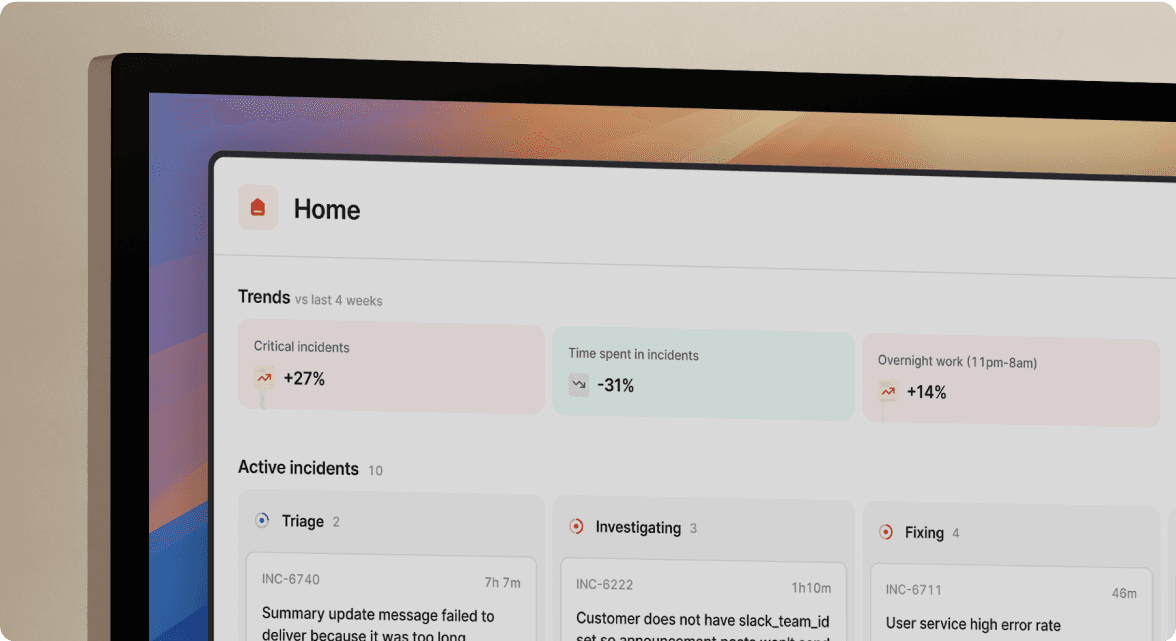Hello, world 👋

We're Pete, Stephen and Chris, and we're building incident.io - the best way for you to respond to, review and learn from your incidents.
Managing incidents is harder than it needs to be
As an engineer, one minute you’re deep in the zone, the next, you have to spring into action: fixing whatever is broken, communicating regularly with stakeholders, maintaining a list of action items, updating a status page that will be seen by potentially millions of customers, all whilst being live on a video call. Oh, and it's 4AM, and this is the third time this has happened this month.

Think about the last incident you were involved in. Did everyone know what they were doing the whole time? Was it calm, collected and organised? Or somewhat chaotic, Slack channels ablaze, questions flying in from all directions in 5 different threads, whilst people constantly repeat a status update to every new person joining the incident?
What about after the incident - do you consistently follow up with a structured incident review or post-mortem, dig into the root cause and ensure actions get owned and implemented? If not, we don’t blame you. Reviewing a noisy Slack channel to curate a timeline is challenging and time consuming, and makes it hard to see whether actions are being followed up on from incidents.
Now zoom out - are things getting better or worse over time? It’s often hard to tell! Incident data is often collated by hand in a spreadsheet, making it time-consuming and error-prone, if you have it at all.
If you’re lucky, your company has dedicated incident managers, training and processes which make your incident response easier. However, we’d still be willing to bet that admin and rote-work are what make a lot of this possible.
Say hello to incident.io 🎉
We’re software engineers who have been pulled into more incidents than we can count, ranging from small blips quickly solved, to massive incidents that required weeks in a war-room. We get it -- we've been there.
We can’t prevent your incidents from happening, or fix them for you - these are things you’re uniquely placed to solve. What we can do is help make them far easier to manage in the moment, learn from once it’s over, and analyse over time to surface more insights.
We're building incident.io to do just that.
A few guiding principles ⭐️
The product will change and grow, but we think these will remain constant.
Reduce noise, don't add to it 🙉
Incidents are stressful places, and there's already enough going on. We’re going to be putting more messages into the mix, but the overall impact should be less noise for those fighting the fires. We should be there when you need us, and out of the way when you don't.
Meet you where you already are 💬
We think good incident response is fundamentally about good communication: investigating what might be wrong, creating and assigning actions to fix it, and updating stakeholders all-the-while. Rather than learning a whole new tool, we've deeply integrated with Slack, so you can create, coordinate, communicate and resolve incidents without going anywhere.
Powerful, with sensible defaults ⚡️
Whatever your setup, there’s more than enough configurability in incident.io, but of the box we want to provide a set of sensible defaults, based on years of experience managing incidents. We'd like you to save your brainpower for the decisions that matter.
You bring the tools, we bring the glue 🤝
You've probably got a set of tools you already love like Google Docs, Zoom, Pagerduty and JIRA. Why replace them? Instead, we’ll glue them together for you so they work better, together. No lifting and shifting required.
Getting early access
If you've faced these issues before and are excited by what we're building, we'd love to hear from you. We're spending the next few months partnering with companies that can help us shape the product as we roll it out.
Right now, incident.io is best suited for technology companies with between 30 and 500 employees. If that's you, excellent! We'd love to talk to you. Make sure you sign up with your email below, and drop us a line at hello@incident.io. Our inboxes are currently empty, and we guarantee we'll get back to you.
Come along for the ride 🚀
We both can't wait to solve these problems. We're building out in the open, and we'll be sharing our progress along the way. If you want to follow us along our journey, give these a shot:
- Follow us on Twitter
- Drop your email in the signup box below
See related articles
So good, you’ll break things on purpose
Ready for modern incident management? Book a call with one of our experts today.

We’d love to talk to you about
- All-in-one incident management
- Our unmatched speed of deployment
- Why we’re loved by users and easily adopted
- How we work for the whole organization



